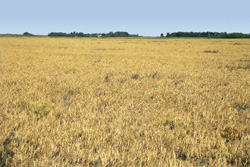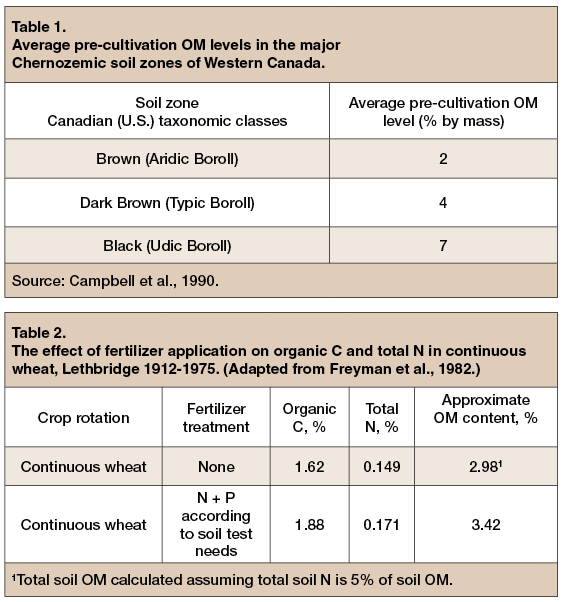
Features
Agronomy
Fertility and Nutrients
Grain protein content in any year comes from two sources
Production of field crops is one of the major activities of agriculture in the Northern Great Plains, and two of the major small grain cereal crops are wheat and barley. Most of the land where these crops are grown has now been farmed for close to 100 years.
November 7, 2008 By Thomas Jensen*
Both fertilizer nitrogen and soil organic matter are involved.
 |
| Mineralization of soil organic matter is a significant source of N to cereal crops. Photo courtesy of Bruce Barker. |
Production of field crops is one of the major activities of agriculture in the Northern Great Plains, and two of the major small grain cereal crops are wheat and barley. Most of the land where these crops are grown has now been farmed for close to 100 years. All grain crops contain protein and a component of protein is N.
During the initial years of crop production on these former grassland soils, crops were grown with no additions of crop nutrients. Crop yields were generally quite good, depending on the amount of moisture received during the growing season. Usually, moisture was and is the main limitation for crop growth. After a couple of decades of crop production, yields of crops began to decline even in years of adequate moisture. It was found in some areas that growing a N-fixing crop such as sweet clover and plowing it under as green-manure resulted in improved wheat growth the following year. The N added to the soil-crop system from the green-manured sweet clover supplied additional N, improving crop yields. This showed that the crops were limited in yield by a decline in plant-available N. The initial abundant sources of N had been available through a process called mineralization. Mineralization is defined as a two-step biological process of decomposition where N in soil organic compounds is first converted to ammonium (NH4+) and in the second step the NH4+ is oxidized to nitrate (NO3-). Most of the grassland soils naturally had abundant levels of organic matter (OM) that had been built up and reached an equilibrium level since the soils began forming after the last ice age. The average levels of OM in the surface horizons of the major grassland soil zones in the Canadian Prairies are shown in Table 1.
Generally, cultivation of original grassland soils results in a loss of OM when the natural vegetation is cultivated under and cropped to annual field crops. Declining levels and quality of OM have been identified as one of the major sources of soil degradation. Nitrogen in the soil at any one time is mostly in the organic form, about 97 to 98 percent. It is contained in the organic molecules of soil humus, plant residues, soil fauna, soil microbes, or animal wastes.
N fertilizer use and N removal from fields
The amount of N added as fertilizer can at times equal the amount of N accounted for in the grain, but sometimes it is less than the N removed in the grain. For example, a 30 bu/ac wheat crop with 13.5 percent protein contains approximately 43 lb of N/ac: 30 bu/ac x 60 lb/bu x 13.5 percent protein ÷ 5.7 = 42.6 lb N. A wheat grower in this example may apply 50 lb N/ac each year in anticipation of an average wheat crop of 30 bu/ac. However, in a year of above average rainfall, the wheat crop may yield higher than normal, e.g. 40 bu/ac. The higher than average yield usually results in a lower level of protein due to a greater amount of carbohydrate storage in the more plump kernels. Even so, the amount of N removed in the grain will be increased up to about 53 lb N: 40 bu/ac x 60 lb/bu x 12.5 percent protein ÷ 5.7 = 52.6 lb N. The additional 3 lb N above the fertilizer N comes from mineralization of N from OM in the soil. Organic N mineralization is a biologically accomplished process that microbes do best when they have a warm and moist, but not saturated, environment. A growing season where there is ample, but not excessive, precipitation and warm temperatures results in good crop growth and is fortunately accompanied with more than average mineralization rates of N.
It is important to realize that all fertilizer N applied in any one year is not taken up into that year’s crop. In fact, an uptake efficiency of 50 percent into the above-ground portion of a crop is considered normal, so every year a significant portion of the N used by a crop actually comes from OM mineralization. The other 50 percent of the applied N becomes part of residual mineral N in the soil (NO3- and NH4+), or becomes part of OM, or is subject to losses. Losses under the semi-arid conditions of the Northern Great Plains are usually quite low. For example, in a fertilizer N study near Carmangay, Alberta, N-15 enriched fertilizer recovery in soil and above-ground crop biomass showed that 43 percent of applied N was in the grain and straw, and 48 percent in the soil down to a 4 ft. depth (1.2 m) for a total recovery of 91 percent. Of the nine percent of N not accounted for, a portion was in root tissues, not sampled or analyzed. It is estimated that actual losses were not more and probably less than nine percent. The OM is made up of different pools, such as stabilized soil organic humus that is slow to decompose, active or easily mineralized soil organic residues in various stages of decomposition, soil microbial biomass, and recent crop residues (e.g. roots, chaff, and straw). Losses of N occur through leaching of NO3-, denitrification of NO3-, and some volatile losses of gaseous ammonia (NH3) from NHb4+- based fertilizers under alkaline pH conditions, urea fertilizer hydrolyzation, or from decomposing crop residues on the soil surface. The pool of OM both consumes mineral fertilizer N and releases mineral N into the soil solution on a continuing basis. In any one growing season, the net amount taken into OM may be a positive or negative amount.
 |
In the previously noted example of an above average rainfall year, more N was released from OM which helps explain why N removal in grain is greater than N applied as fertilizer. In a drier than average year, for example, 20 bu/ac of 15 percent N protein wheat, only about 32 lb N (20 bu/ac x 60 lb/bu x 15 percent protein ÷ 5.7 = 31.6 lb N) is removed in the grain from an acre of land. If the typical rate of 50 lb N/ac was applied as fertilizer before planting, a net addition of about 18 lb N may result. This extra 18 lb N will be portioned between mineral N and OM in the soil.
If N removal is consistently more than N fertilizer additions, OM levels will gradually decline. There are some natural N additions to the soil-plant system from aerial and precipitation deposition, N fixation by free-living soil microbes, and possibly some input of N from deep within the soil from movement upward of groundwater with some soluble N in the form of NO3-. In a long-term rotational study at Lethbridge, Alberta, the level of total soil N was seen to stabilize at slightly less than 0.15 percent after 70 years of cropping to wheat with no addition of N or any other fertilizers. When fertilizers were regularly added to the soil, the amount and quality of organic carbon (C) and total N were stabilized at higher levels (Table 2).
Predicting the amount of N mineralization
The natural cycling of N between the pool of OM and plant available mineral N (NH4+ and NO3-) has been studied and there have been measurements of the amount of N mineralized. Campbell et al. (1988) observed that the amount of N mineralized was affected by the amount of precipitation received in a growing season. In a Brown loam soil at Swift Current, Sask., the net amount of N mineralized was represented by the following equation:
Nmin = 23 + 0.29 precipitation, (r=0.75 at p<0.05).
Soil samples can be incubated in a laboratory at a constant moisture content and temperature to estimate the amount of mineral N generated over a certain time. Another way is to extract mineral N using a hot potassium chloride (KCl) solution. Yet another way is to use a formula similar to the one noted above, but to include the OM content as well as an estimation of precipitation to calculate net N mineralized. This is used in the fertilizer test prediction program Virtual Soil Test (VST) developed by Rigas Karamanos of Westco Fertilizers. For example, in a Thick Black soil with an average OM of 5.5 percent, the following are estimates of net N mineralized for a dry, average, and above average precipitation year, respectively, 34, 62 and, 74 lb N/ac. The amount of additional N that could be mineralized in a wet year compared to a dry year is 40 lb N/ac.
Conclusion
The amount of N removed from a field in the grain of a crop of wheat or other Northern crop can be less than, equal to, or greater than the amount of N applied as fertilizer in that specific year. In a favourable moisture year, the additional N supplied to a crop comes from the mineralization of N from the OM present in a soil. This OM has been a source of N for crops in the Northern Great Plains, but studies have shown the source can be depleted. Addition of N and other required nutrients as fertilizer can help increase crop yields and maintain the levels of OM in soils.
*Thomas Jensen is the Northern Great Plains Director for the International Plant Nutrition Institute. This article is reprinted with permission from the IPNI Insights regional newsletter.